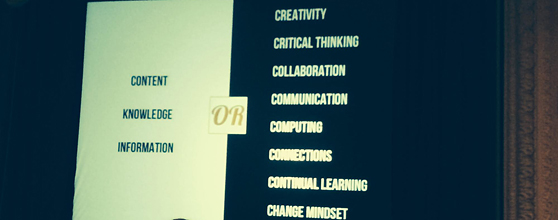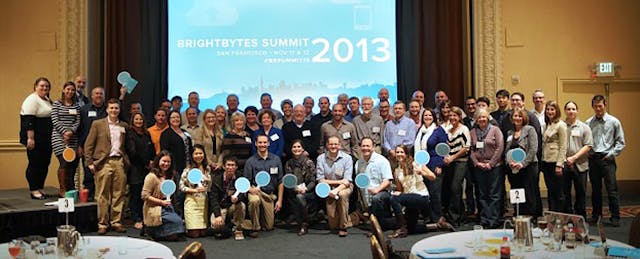BrightBytes gathered 50 education leaders (all current Brightbytes customers) for a two-day summit in SF on November 11 and 12 to introduce Clarity 3.0, the latest version of its product that aims to help schools understand and analyze their technology use in a way that is educative, engaging and actionable.
The conference kicked off with a keynote from Will Richardson, a long-time educator and blogger who also co-wrote Personal Learning Networks: Using the Power of Connections to Transform Education with BrightBytes CEO Rob Mancabelli.
Richardson jump-started a conversation that would be a recurring theme throughout the conference: learning as a social and networked experience. Both he and David Weinberger, researcher and author of Too Big to Know, challenged attendees to see education and learning as less of a solitary place of content, knowledge and information, and more like a community network facilitating the building of skills like creativity, critical thinking, and collaboration.
Which are we seeing in schools?

This community was in full force as educators and the BrightBytes team of eighteen spent most of the two days sharing ideas and feedback. Besides product presentations, a discussion on gaming and engagement based on a new white paper co-written by BrightBytes and co.lab, and even an improv session, attendees got to test drive version 3.0 of the Clarity platform, which measures the impact of school technology use on student achievement.
The teachers were tasked with using the platform to address hypothetical--but common--issues for educators. One example: proposing the implementation a BYOD initiative by researching students’ access to technology at home. Using Clarity 3.0, teachers were able to access information about the types of devices students had at home, as well as the ratio of users to device and other key facts instrumental to the proposal.
Solving problems together in small groups, participants became more familiar with navigating the data dashboard and diving into detailed reports based on Clarity’s CASE Framework.
A CASE for Measuring Impact
The CASE framework refers to Classroom, Access, Skills, and Environment, the four domains that BrightBytes analyzes to evaluate the impact of tech integration on student achievement. This framework examines how teachers and students use specific technologies in the classroom for learning and as well as their access to technology at home. CASE also evaluates teacher and student relevant technology skills as well as policies and administrative issues that impact the learning environment. Each district and school is scored across these four domains based on surveys of teachers, students and parents about technology use in learning.
Clarity also provides step-by-step plans with recommendations on how to improve based on plans developed by experts and successfully implemented at schools. The platform also provides a way of managing projects and professional development initiatives across schools within a district. The impact of these programs on both professional development and learning is measured according to the 4 C’s: communication, collaboration, critical thinking, and creativity.
What Educators Said
Education leaders from schools across the country were encouraged to reflect and share their thoughts on the Clarity platform, with breakout activities and small group discussions at each table. Designated reflection times after each activity allowed participants to capture insights in a “Passport to the Future of Learning”, a guided journal provided for each participant. The alternation between large group presentations, hands-on activities, small interactive discussions, and reflection time reflected best teaching practices employed by educators. Many participants affirmed the importance of daily reflection for their students and commented on the need for more “meta” time.
During the speed learning round, several district leaders shared about how their BrightBytes data enabled them to find the “bright spots” in their schools, where teachers and students were effectively using their devices. Discoveries of effective implementation often guided future spending, and allowed for release time, where teachers could visit and learn from those on the path ahead.
One of the recurring conversations heard about the summit was the impact Clarity had on teacher professional development. Jon Pennington, a Technology Coordinator for Assets School in Honolulu who has used Clarity for 2 years, shared how the platform highlighted areas teachers had significant--or no--interest in learning more about. “We were also able to see that our middle-school teachers were greatly interested in attending PD focused on multimedia skills, and had little interest in developing their online skills,” he says. “We were able to share this data with teachers and offer several new courses centered on image/video creation/editing and how multimedia can integrated to enhance student projects.”
As participants moved throughout the venue and interacted with BrightBytes staff stationed at tables, they dived into discussions on features they wanted to see in future versions of the Clarity platform. It was clear (no pun intended) that the staff welcomed feedback and took comments to heart. One popular request was for an app that would provide formative feedback to classroom teachers on evidence of the four C’s: communication, collaboration, critical thinking, and creativity, in their teaching practices.
The key to successful implementation of Clarity 3.0 will happen in the: Now what? The true work begins in the all important follow up conversations, referred to as, “data dialogues,” that result when districts and schools receive their data.
It was clear (no pun intended) that Clarity can supply plenty of quantitative data on the effect that technology has on student outcomes. The key to its success rests in the ability of human minds to interpret the data and take meaningful action.


